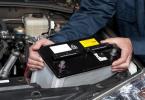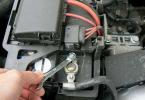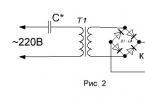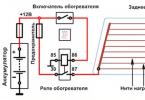You can choose a radial-thrust ball bearing using our bearing catalog
Angular contact ball bearings(ball bearings) designed for the perception of radial and axial loads. Their ability to take axial load depends on the contact angle, which is the angle between the plane of the centers of the balls and the straight line passing through the center of the ball and the point of contact of the ball with the raceway. With an increase in the contact angle, the axial load capacity increases due to a decrease in the radial one.
By speed characteristics radially- thrust bearings are not inferior to radial single-row. An increase in the contact angle leads to a decrease in the permissible rotational speeds and an increase in the one-sided axial load perceived by the bearings.
Bearings are installed on rigid double-bearing shafts with a small distance between the supports, as well as in units where it is required to adjust the bearing clearance during installation or during operation.
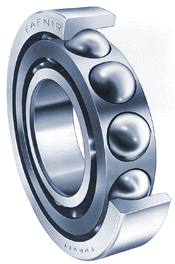
A single-row angular contact ball bearing perceives radial and axial loads, and the axial load - only in one direction; an angular contact ball bearing is mounted opposite a second bearing, which takes the load in the opposite direction. Angular contact ball bearings are one-piece. They are suitable for high frequencies rotation. The ability to self-align is very small.
Separators
Most of the angular contact ball bearings have a massive cage with glass-filled polyamide windows. They are suitable for long-term temperatures up to 120 ° C. When lubricated, the additives in the oil can shorten the life of the separator. Old oil under conditions high temperatures can also reduce the longevity of the separator, therefore oil change times must be observed.
Universal bearings for complete mounting
These bearings are specially produced adapted for installation in any order, with the only condition that they must be mounted close to each other; this achieves the prescribed axial internal clearance or uniform load distribution without the use of shims or other similar devices.
Skew
Angular contact ball bearing (fig. 24.10) is designed for combined (radial and axial) or purely axial loads. Bearings mounted in pairs absorb axial forces in both directions. They are used at high speeds.
Angular contact ball bearings are almost always used in a paired mirror installation with mandatory axial tightening. The tightening method and bearing arrangement affect the performance of the assembly.
Angular contact ball bearing (see Fig. 17.1, b) is designed to accept a combined load: radial and one-sided axial. The load capacity of these bearings is higher than that of radial ball bearings due to the large number of rolling elements that can be accommodated in the bearing due to the chamfer on the outer or inner ring. With increasing a, the axial load rating of the bearing increases, while the limiting speed and permissible radial load decrease. Cages for these bearings are usually massive. Currently, bearings are produced with contact angles of 15, 25 and 36, which are distinguished by the presence of a bevel on the inner ring and centering of the cage on the outer ring. This allows the limiting speed to be significantly increased due to the more favorable lubrication conditions.
Angular contact ball bearing with a split inner ring (see Fig. 17.1, d), depending on the shape of the raceways, has three or four-point contact of the ball with the rings and is designed to absorb radial and axial loads in both directions. There are similar bearings with a split outer ring.
Angular contact ball bearings (Fig.3.160) are able to perceive combined radial axial loads... Their axial carrying capacity depends on the contact angle a. With an increase in the angle a, the axial load capacity increases due to a decrease in the radial one. Bearings can only take axial loads in one direction.
The angular contact ball bearing is lubricated with oil, which is sprayed through the bearings by means of an oil ring. The oil, having passed through the bearings, returns back to the reservoir and is cooled by water.
Angular contact ball bearing is designed to operate under conditions of simultaneously acting radial and axial loads (for axial forces - only in a certain direction); can also take a purely axial load. Bearings mounted in pairs can also carry a purely radial load. The preload increases bearing capacity, rigidity, rotation accuracy and durability. When installing in pairs with a preload that rigidly fixes the shaft in the radial and axial directions in both directions, it is necessary to adjust the preload depending on the axial load. These bearings are used in rigid double bearing shafts with small bearing spacings.
Angular contact ball bearings are designed for the simultaneous perception of radial and one-sided axial loads. They are used at the speed of rotation of the shaft I 10 000 rpm I min.
Angular contact ball bearing is designed to operate under conditions of simultaneously acting radial and axial loads (for axial forces - only in a certain direction); can also take purely axial load. Bearings mounted in pairs can also carry a purely radial load. The preload increases bearing capacity, rigidity, rotation accuracy and durability. When installing in pairs with a preload that rigidly fixes the shaft in the radial and axial directions in both directions, it is necessary to adjust the preload depending on the axial load. These bearings are used in rigid double bearing shafts with small bearing spacings.
| Roller Needle Bearing | Angular contact ball bearing | Tapered roller bearing | Tapered roller bearing with thrust flange | Thrust ball bearing. |
Bearings are produced in a wide range and are subdivided by size and design. The simplest, most reliable and service-friendly are deep groove ball bearings. They are subdivided into several subspecies, each with its own purpose.
Single-row bearings are used as economical rolling bearings in production. They are most commonly supplied with stamped cages, and large ball bearings are used with machined brass cages. Raceways have slightly larger arcs than balls. It follows from this that, in addition to radial, they are able to withstand axial loads from both sides, including when operating at high speeds.
Catalog:
Single row deep groove ball bearings are manufactured with shields (suffix Z or 2Z) and contact seals (suffix RSH, 2RSH or DU, DDU) both on one side and on both sides. Bearings are manufactured with lifetime lubrication if they are closed ( temperature regime greases from -30 0 to +110 0 C). Under no circumstances should they be heated before installation! Manufacturers recommend using a special assembly tool.
The design of the bearing unit is simplified by deep groove ball bearings with a groove in the outer ring. They are fixed in the housing using a locating ring. Set rings are available separately or with a bearing.
Single row deep groove ball bearings are manufactured in the following configurations:
- instrumental and miniature;
- made of stainless steel;
- with a small cross-section (thin rings);
- inch bearings;
- for kiln trolleys;
- with tapered holes;
- for conveyor rollers;
- with spherical outer ring.
Single row ball bearings are installed in pairs if the shaft is fixed on both sides in the axial direction with a clearance. The paired deep groove ball bearings are matched one-to-one in such a way that no spacer rings or other devices are used during installation, and the load is evenly distributed. The bearing pairs are available in three different designs:
- tandem installation (DT);
- installation by the rear end to the rear end (DB);
- front-to-front (DF) installation.
To ensure the correct installation of the bearings, a "V" sign is applied to the outer surface of the rings, it follows that the kit will work in accordance with the specified technical characteristics... The matched pair of bearings is supplied in a complete package.
